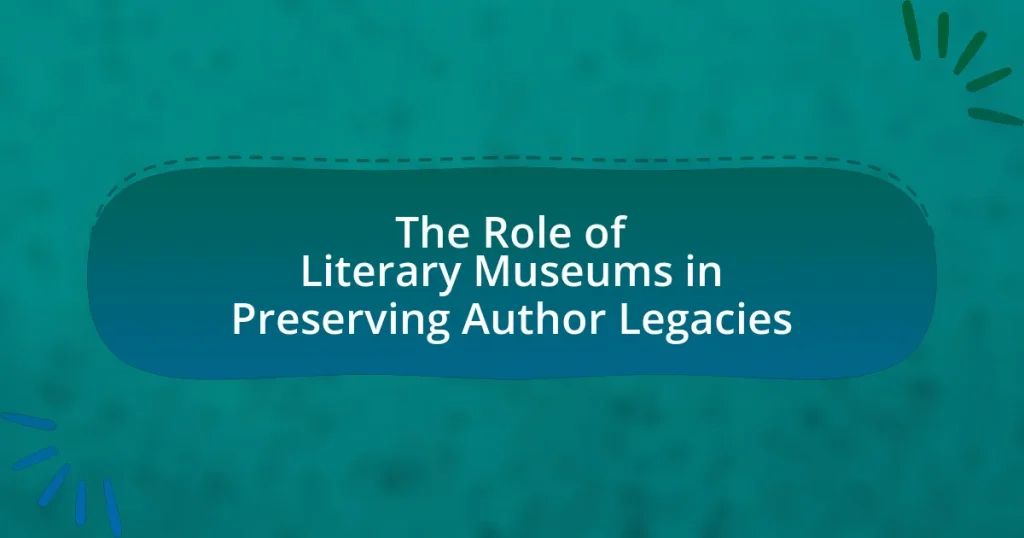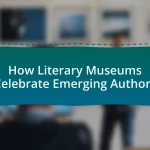Literary museums serve a vital function in preserving the legacies of authors by curating their works, personal artifacts, and historical contexts. These institutions collect manuscripts, letters, and memorabilia that provide insights into authors’ lives and creative processes, ensuring their contributions to literature remain accessible to future generations. Through exhibitions, educational programs, and community engagement, literary museums enhance understanding of authors’ works and foster appreciation for literary heritage. They face challenges such as funding limitations and the need for accurate representation, yet they continue to adapt by integrating digital technologies and interactive experiences to meet evolving visitor expectations.
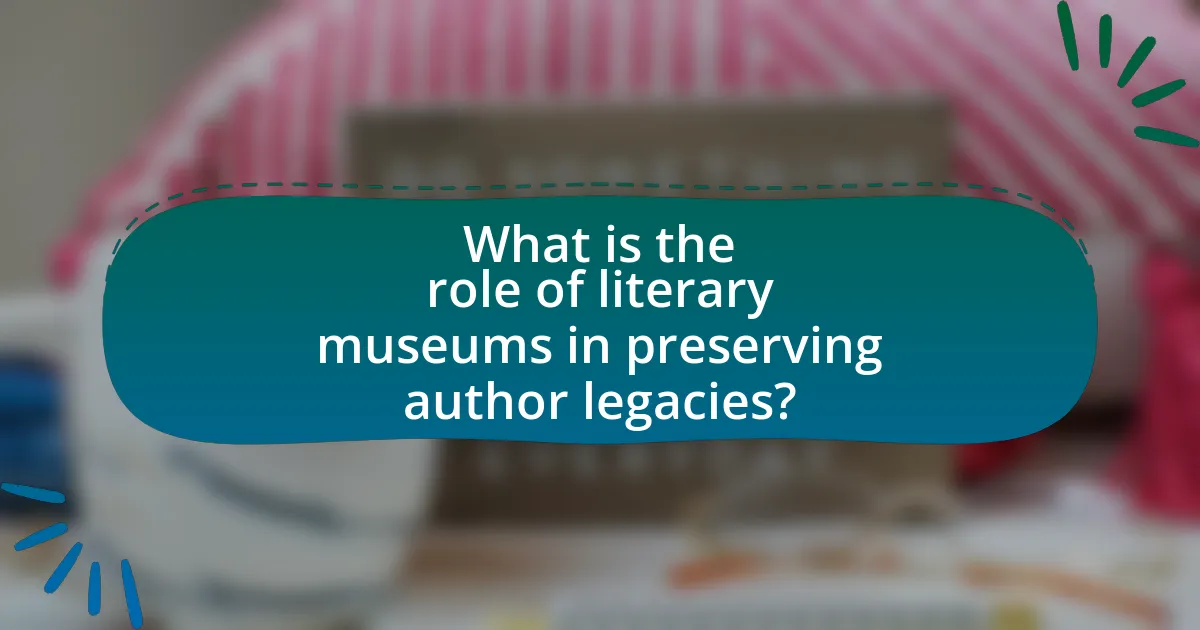
What is the role of literary museums in preserving author legacies?
Literary museums play a crucial role in preserving author legacies by curating and showcasing their works, personal artifacts, and historical context. These institutions collect manuscripts, letters, and memorabilia that provide insight into the authors’ lives and creative processes, thereby maintaining a tangible connection to their contributions to literature. For example, the Ernest Hemingway Home and Museum in Key West preserves the author’s residence and personal belongings, allowing visitors to experience his environment and understand his influences. Additionally, literary museums often host educational programs, exhibitions, and events that promote the authors’ works, ensuring their relevance and accessibility to future generations. This active engagement helps to solidify the authors’ places in literary history and fosters ongoing appreciation for their contributions.
How do literary museums contribute to the understanding of an author’s work?
Literary museums enhance the understanding of an author’s work by providing contextual insights into their life, creative process, and historical background. These institutions often house original manuscripts, personal artifacts, and letters that illuminate the author’s intentions and influences. For example, the Ernest Hemingway Home and Museum in Key West showcases Hemingway’s writing environment and personal belongings, allowing visitors to grasp the nuances of his literary contributions. Additionally, exhibitions and guided tours often include expert commentary that connects the author’s life experiences to their literary themes, further enriching the visitor’s comprehension.
What types of artifacts do literary museums collect to represent authors?
Literary museums collect a variety of artifacts to represent authors, including manuscripts, letters, personal belongings, photographs, and first editions of their works. These items provide insight into the authors’ lives, creative processes, and historical contexts. For example, manuscripts and letters often reveal the author’s thoughts and revisions, while personal belongings can illustrate their daily lives and influences. Photographs and first editions serve to connect visitors with the authors’ legacies and the literary movements they were part of, enhancing the understanding of their contributions to literature.
How do exhibitions in literary museums enhance visitor engagement with authors’ legacies?
Exhibitions in literary museums enhance visitor engagement with authors’ legacies by providing immersive experiences that connect visitors directly to the authors’ works and personal histories. These exhibitions often feature original manuscripts, personal artifacts, and interactive displays that allow visitors to explore the context in which the authors created their works. For instance, the British Library’s exhibition on Charles Dickens included his handwritten manuscripts and personal letters, which deepened visitors’ understanding of his life and literary contributions. Such tangible connections foster a more profound appreciation for the authors’ legacies, encouraging visitors to engage with their literature in a meaningful way.
Why are literary museums important for cultural heritage?
Literary museums are important for cultural heritage because they preserve and promote the legacies of authors and their works. These institutions serve as repositories of manuscripts, letters, and personal artifacts, providing tangible connections to literary history. For example, the Ernest Hemingway Home and Museum in Key West showcases Hemingway’s life and writings, allowing visitors to engage with his contributions to literature. By curating exhibitions and educational programs, literary museums foster appreciation for literary traditions and encourage the exploration of cultural narratives, thus reinforcing their significance in the broader context of cultural heritage.
How do literary museums promote the preservation of literary history?
Literary museums promote the preservation of literary history by curating and displaying artifacts, manuscripts, and personal items related to authors and their works. These institutions serve as repositories of knowledge, ensuring that significant literary contributions are documented and accessible to the public. For instance, the British Library houses original manuscripts from renowned authors like Charles Dickens and Virginia Woolf, providing tangible connections to their literary legacies. Additionally, literary museums often host educational programs, exhibitions, and events that engage the community and foster an appreciation for literary heritage, thereby reinforcing the importance of preserving these cultural narratives.
What impact do literary museums have on local communities and tourism?
Literary museums significantly enhance local communities and tourism by serving as cultural hubs that attract visitors and foster community engagement. These institutions often host events, workshops, and exhibitions that celebrate local authors and literary heritage, thereby increasing foot traffic and economic activity in the surrounding area. For instance, a study by the American Alliance of Museums found that museums contribute approximately $50 billion annually to the U.S. economy, with a substantial portion stemming from tourism related to cultural attractions. Additionally, literary museums often collaborate with local schools and organizations, promoting literacy and education, which strengthens community ties and encourages a shared appreciation for literature.
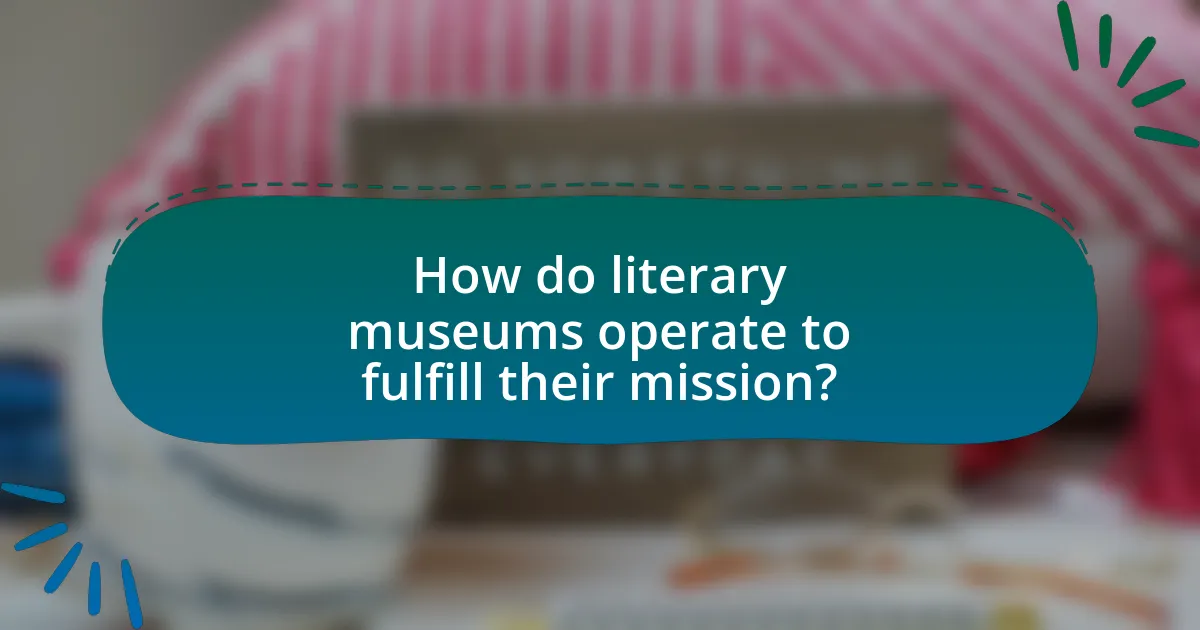
How do literary museums operate to fulfill their mission?
Literary museums operate by curating and displaying artifacts, manuscripts, and personal items related to authors to educate the public about their lives and works. These institutions engage in research, organize exhibitions, and host educational programs that promote literary heritage and foster appreciation for literature. For example, the British Museum houses a vast collection of literary artifacts, which helps to contextualize the works of authors like Charles Dickens and Virginia Woolf, thereby fulfilling their mission of preserving and promoting literary legacies.
What are the key functions of literary museums in preserving legacies?
Literary museums play a crucial role in preserving legacies by curating and showcasing the works, lives, and contexts of authors. These institutions collect manuscripts, letters, and personal artifacts, which provide tangible connections to the authors and their creative processes. For example, the Ernest Hemingway Home and Museum in Key West preserves Hemingway’s personal belongings and manuscripts, allowing visitors to engage with his life and work directly. Additionally, literary museums often host educational programs, exhibitions, and events that promote awareness and appreciation of literary heritage, ensuring that the contributions of authors are recognized and remembered. This multifaceted approach not only safeguards the physical remnants of literary figures but also fosters a deeper understanding of their impact on culture and society.
How do literary museums curate their collections?
Literary museums curate their collections by systematically acquiring, preserving, and displaying artifacts related to authors and their works. This process often involves evaluating the historical significance, authenticity, and relevance of items such as manuscripts, letters, personal belongings, and first editions. For instance, the British Library employs a rigorous selection process to ensure that its collections reflect the literary heritage of the UK, including significant works by authors like Charles Dickens and Virginia Woolf. Additionally, curators often collaborate with literary scholars and institutions to enhance the contextual understanding of the items, ensuring that the collections serve educational purposes and engage the public effectively.
What role do educational programs play in literary museums?
Educational programs in literary museums serve to enhance public understanding and appreciation of literary heritage. These programs facilitate engagement with the works and lives of authors, often through workshops, lectures, and guided tours that provide context and insight into literary movements and historical periods. For instance, the American Writers Museum offers educational initiatives that connect visitors with the contributions of American authors, thereby fostering a deeper connection to the literary canon. Such programs not only preserve author legacies but also promote literacy and critical thinking skills among diverse audiences.
How do literary museums collaborate with authors and their estates?
Literary museums collaborate with authors and their estates by establishing partnerships that facilitate the preservation and promotion of the authors’ works and legacies. These collaborations often involve agreements that allow museums to display manuscripts, personal artifacts, and other materials directly related to the authors, ensuring that their contributions to literature are accurately represented. For instance, the Ernest Hemingway Home and Museum works closely with the Hemingway estate to curate exhibitions that reflect the author’s life and literary achievements, providing authentic insights into his work. Such partnerships also enable museums to host events, lectures, and educational programs that engage the public and foster a deeper understanding of the authors’ impact on literature and culture.
What agreements are typically made between literary museums and authors’ estates?
Literary museums typically enter into licensing agreements with authors’ estates to secure the rights to display manuscripts, letters, and other personal artifacts. These agreements often outline the terms of use, duration, and any financial compensation involved, ensuring that the museum can legally exhibit the author’s work while respecting the estate’s intellectual property rights. For example, the estate may require that the museum adheres to specific guidelines regarding the presentation and interpretation of the author’s legacy, thereby maintaining the integrity of the author’s image and message.
How do these collaborations enhance the authenticity of exhibitions?
Collaborations enhance the authenticity of exhibitions by integrating diverse expertise and resources, which enriches the narrative and presentation of the author’s legacy. For instance, partnerships with scholars, local communities, and other cultural institutions allow for a more comprehensive portrayal of an author’s life and work, ensuring that multiple perspectives are represented. This collaborative approach not only validates the information presented but also fosters a deeper connection with the audience, as it reflects a collective effort to honor the author’s contributions. Studies have shown that exhibitions featuring collaborative elements tend to attract higher visitor engagement, indicating that authenticity resonates with audiences.
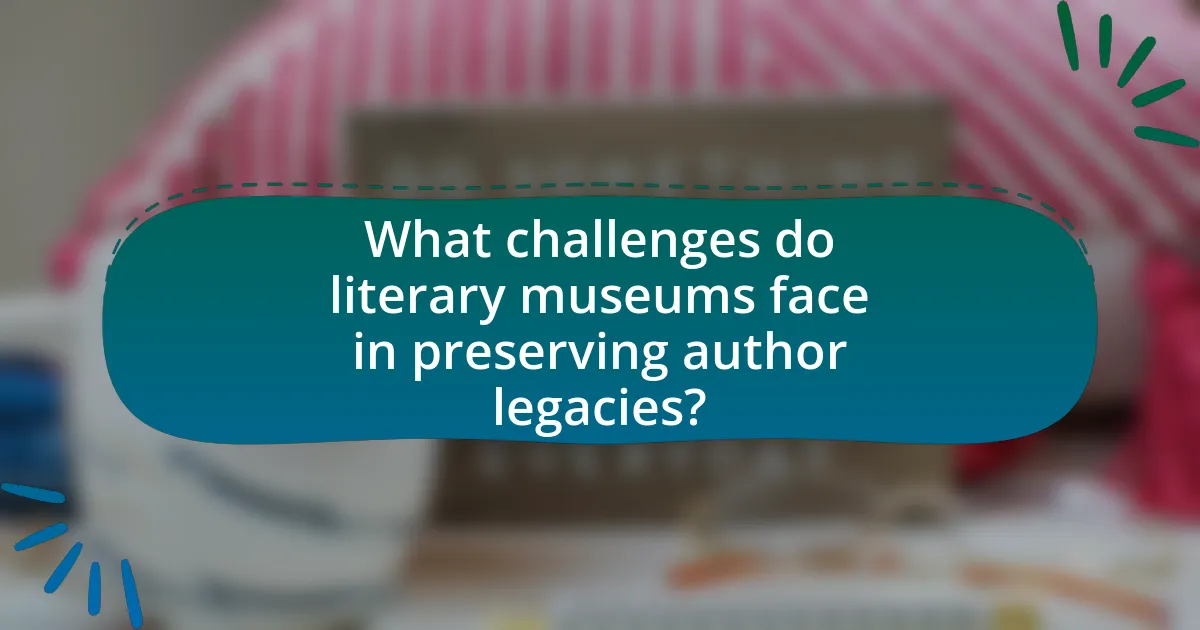
What challenges do literary museums face in preserving author legacies?
Literary museums face several challenges in preserving author legacies, including limited funding, the need for accurate representation, and the evolving nature of public interest. Limited funding restricts the ability of these institutions to acquire and maintain artifacts, which are crucial for showcasing an author’s life and work. Accurate representation is essential, as misinterpretations or oversimplifications can distort an author’s legacy, leading to public misconceptions. Additionally, the evolving nature of public interest means that museums must continually adapt their exhibits and educational programs to engage contemporary audiences, which can be resource-intensive and complex. These challenges highlight the difficulties literary museums encounter in their mission to honor and preserve the legacies of authors effectively.
How do funding and resources affect the operations of literary museums?
Funding and resources significantly impact the operations of literary museums by determining their ability to maintain exhibits, conduct educational programs, and preserve collections. Adequate funding allows museums to hire qualified staff, invest in technology for preservation, and create engaging visitor experiences. For instance, the American Alliance of Museums reported that institutions with stable funding can enhance their outreach and educational initiatives, which are crucial for preserving author legacies. Conversely, limited resources can lead to reduced operational hours, fewer exhibitions, and diminished public engagement, ultimately hindering the museum’s mission to honor and preserve the contributions of literary figures.
What strategies can literary museums employ to secure funding?
Literary museums can employ diverse strategies to secure funding, including grant applications, partnerships with educational institutions, and community engagement initiatives. Grant applications to government bodies and private foundations can provide substantial financial support, as evidenced by the National Endowment for the Arts, which awarded over $27 million in grants to arts organizations in 2020. Partnerships with universities can facilitate research funding and collaborative programs, enhancing visibility and attracting donors. Additionally, community engagement initiatives, such as workshops and literary events, can foster local support and increase membership, leading to sustainable funding sources.
How do technological advancements impact the preservation of literary artifacts?
Technological advancements significantly enhance the preservation of literary artifacts by providing innovative methods for digitization, restoration, and conservation. For instance, high-resolution imaging techniques allow for the detailed documentation of fragile texts, enabling scholars to study them without physical handling, which reduces wear and tear. Additionally, climate-controlled storage solutions and advanced materials for archival purposes help protect these artifacts from environmental damage. The use of digital archives and online databases facilitates broader access to literary works, ensuring their longevity and relevance in contemporary scholarship. These advancements collectively contribute to the safeguarding of literary heritage, as evidenced by initiatives like the Digital Public Library of America, which digitizes and preserves millions of cultural artifacts for future generations.
What are the future trends for literary museums in preserving legacies?
Future trends for literary museums in preserving legacies include the integration of digital technologies, interactive exhibits, and community engagement initiatives. Literary museums are increasingly adopting virtual reality and augmented reality to create immersive experiences that allow visitors to engage with authors’ works and lives in innovative ways. For instance, the use of digital archives enables broader access to rare manuscripts and personal artifacts, enhancing educational outreach. Additionally, museums are fostering partnerships with local communities to co-create exhibitions, ensuring diverse narratives are represented and that the legacies of underrepresented authors are preserved. These trends reflect a shift towards more inclusive, accessible, and technologically advanced methods of legacy preservation in literary museums.
How can literary museums adapt to changing visitor expectations?
Literary museums can adapt to changing visitor expectations by incorporating interactive technologies and personalized experiences. For instance, the integration of augmented reality (AR) and virtual reality (VR) can enhance visitor engagement by allowing them to experience literary works in immersive environments. A study by the American Alliance of Museums indicates that 70% of visitors prefer interactive exhibits, highlighting the demand for more engaging content. Additionally, offering tailored tours and programs that cater to diverse audiences, such as families, students, and international visitors, can meet varying interests and enhance visitor satisfaction. By embracing these strategies, literary museums can effectively respond to evolving visitor preferences while fulfilling their mission of preserving author legacies.
What role will digital technology play in the future of literary museums?
Digital technology will play a transformative role in the future of literary museums by enhancing visitor engagement and expanding access to literary works. Through virtual reality experiences, museums can recreate historical settings and author environments, allowing visitors to immerse themselves in the literary context. Additionally, digital archives will enable broader access to rare manuscripts and documents, facilitating research and education. For instance, the British Library’s digitization project has made millions of historical texts available online, demonstrating how technology can preserve and disseminate literary heritage. Furthermore, interactive exhibits powered by augmented reality can provide personalized storytelling experiences, making literature more accessible and engaging for diverse audiences.
What best practices can literary museums adopt for effective legacy preservation?
Literary museums can adopt several best practices for effective legacy preservation, including the digitization of manuscripts and artifacts, the establishment of comprehensive archival systems, and the development of educational programs. Digitization allows for the preservation of fragile materials while making them accessible to a wider audience; for instance, the British Library has digitized over 1 million items, enhancing public engagement. Comprehensive archival systems ensure that all materials are cataloged and stored properly, which is crucial for long-term preservation; the Library of Congress employs strict archival standards to maintain its collections. Educational programs, such as workshops and exhibitions, foster community involvement and raise awareness about the authors’ legacies, as seen in the initiatives by the Ernest Hemingway Home and Museum, which promote literary heritage through interactive experiences. These practices collectively contribute to the sustainable preservation of literary legacies.
How can literary museums enhance community involvement in their programs?
Literary museums can enhance community involvement in their programs by actively engaging local residents through collaborative events, workshops, and educational initiatives. For instance, hosting writing workshops led by local authors or community members fosters a sense of ownership and participation. Additionally, literary museums can create partnerships with schools and community organizations to develop programs that reflect local literary heritage, thereby increasing relevance and interest. Research indicates that museums that incorporate community feedback into their programming see higher attendance and participation rates, demonstrating the effectiveness of such inclusive approaches.
What methods can be used to evaluate the impact of literary museums on author legacies?
Methods to evaluate the impact of literary museums on author legacies include visitor surveys, academic research, and social media analysis. Visitor surveys can quantify visitor engagement and satisfaction, providing insights into how museums shape perceptions of authors. Academic research often examines the historical and cultural significance of museums, analyzing their role in preserving and promoting author legacies through exhibitions and educational programs. Social media analysis can track public discourse and sentiment regarding authors and their works, revealing how museums influence contemporary understanding and appreciation of literary figures. These methods collectively offer a comprehensive view of the influence literary museums have on the legacies of authors.
